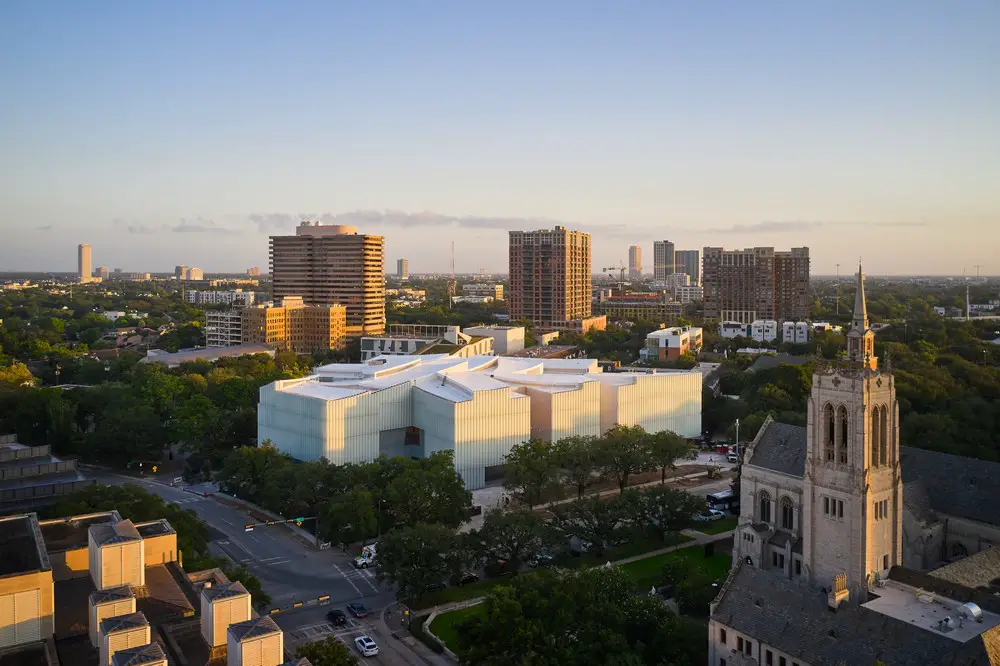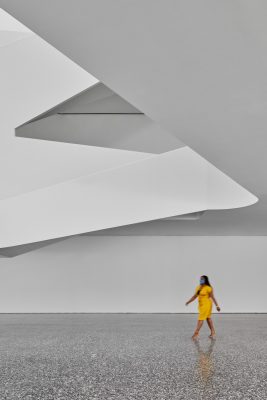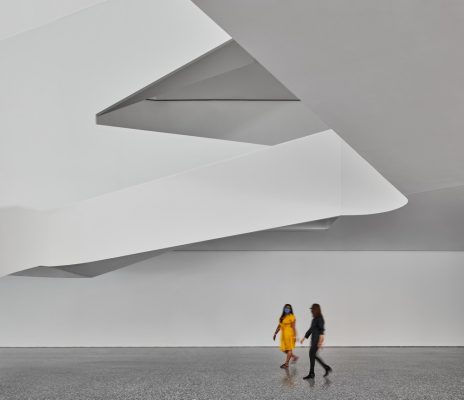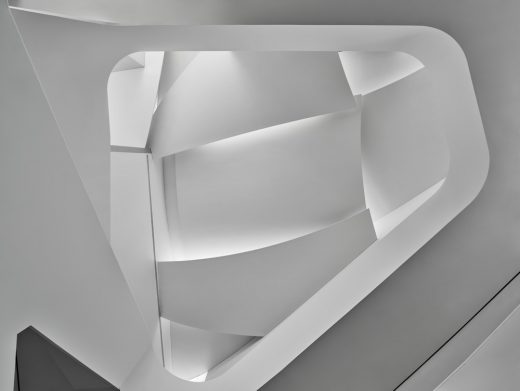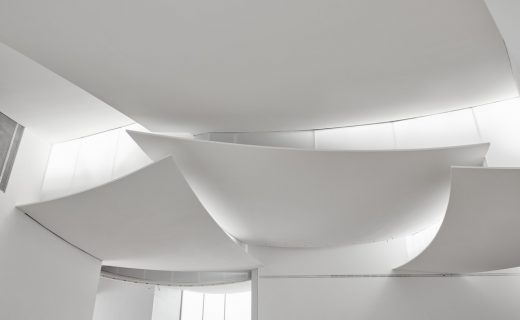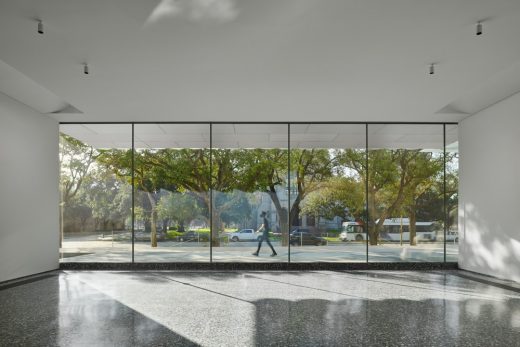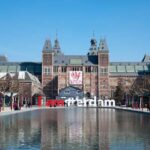Museum of Fine Arts Houston Nancy and Rich Kinder Building, MFAH photos, Modern Texas architecture, USA architect
Nancy and Rich Kinder Building, MFAH Texas
post updated March 22, 2024
Nov 16, 2020
The Museum of Fine Arts, Houston will open its Nancy and Rich Kinder Building to the public on Saturday, November 21, culminating a week of previews for staff, donors, members, and community partners:
Nancy and Rich Kinder Building Houston
Sep 15, 2020
Nancy and Rich Kinder Building, Museum of Fine Arts Houston
Design: Steven Holl Architects
Museum Of Fine Arts Houston Opens New Steven Holl Building On 21 November
Nancy and Rich Kinder Building from above:
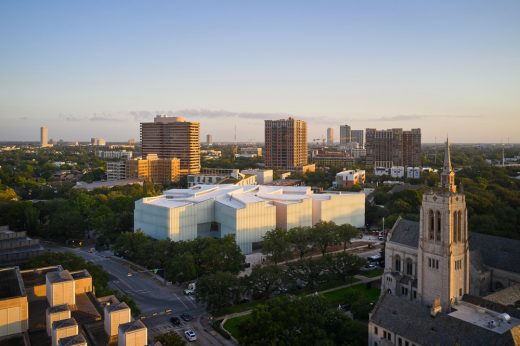
photograph : Peter Molick, Thomas Kirk III
MFAH ANNOUNCES DETAILS OF INAUGURAL INSTALLATIONS
IN ITS NEW NANCY AND RICH KINDER BUILDING,
OPENING TO THE PUBLIC SATURDAY, NOVEMBER 21
Dedicated to the Museum’s first comprehensive display of its international collections of modern and contemporary art, galleries span media from painting and sculpture to craft and design, video, and immersive installations
HOUSTON—September 15, 2020—Gary Tinterow, Director, the Margaret Alkek Williams Chair, the Museum of Fine Arts, Houston, today announced details of the installations that will be on view when the new Nancy and Rich Kinder Building opens to the public on Saturday, November 21, 2020. This date is adjusted from the originally forecast date of November 1, due to the effects of the pandemic, and recent hurricane preparations, on final construction work.
Exterior view of the Nancy and Rich Kinder Building:
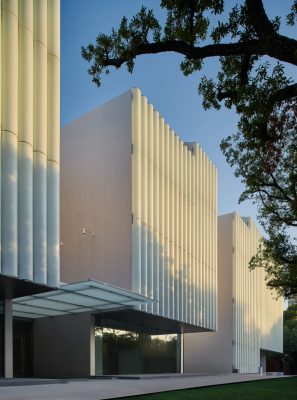
photograph : Peter Molick
Designed by Steven Holl Architects as the third gallery building on the MFAH Susan and Fayez S. Sarofim Campus, the Kinder Building is dedicated to presenting works from the Museum’s international collections of modern and contemporary art. It will open with the first comprehensive installation of these works, drawn from the collections of Latin American and Latino art; photography; prints and drawings; decorative arts, craft, and design; and modern and contemporary art.
In celebration of the opening, the Museum will offer free general admission to all three of its Sarofim Campus gallery buildings for opening weekend, and to the Kinder Building through Wednesday, November 25.
Gary Tinterow said, “In the dynamic spaces that Steven Holl Architects has designed for the Nancy and Rich Kinder Building, our distinctive holdings of modern and contemporary art will soon have the showcase they deserve. This area of our collection continues to grow rapidly, thanks to the exceptional endowment for acquisitions provided by our donors, with the late Caroline Wiess Law at the forefront. We are thrilled that we can now present recent purchases and our historic acquisitions in depth and breadth, bringing our audiences a wealth of recognized masterpieces as well as discoveries by lesser-known artists.”
The Nancy and Rich Kinder Building contains both departmental and cross-departmental galleries. This approach will allow visitors to not only delve into the materials, geographies, and art forms in which modern and contemporary art have developed, but also to explore the ways in which varied artistic ideas, styles, and themes have transcended those boundaries. The multiple stories of modern and contemporary art-making are articulated throughout the building.
A flexible black-box gallery at the street-level entry of the Kinder Building will be permanently devoted to immersive installations. The three inaugural works will be The Hydrospatial City (1946–72), a hovering, utopian vision for an architecture in outer space by Argentinean artist Gyula Kosice; Caper, Salmon to White: Wedgework (2000), a light-filled environment by American artist James Turrell; and Aftermath of Obliteration of Eternity (2009), an Infinity Light Room by Japanese artist Yayoi Kusama.
A windowed gallery facing Main Street on this level includes Lezart I (1989), a monumental configuration of embroidered silk, metal objects, and cast-metal lizards by Brazilian artist Tunga, adjacent to the Museum’s historic 1965 acquisition of kinetic sculptures by Swiss artist Jean Tinguely. Moon Dust (Apollo 17) (2009), an installation of suspended lights by American artist Spencer Finch, will hang in the café space.
The second-floor galleries will be organized by curatorial department, and each will highlight collection strengths. Suites of galleries will be devoted to the history of photography; decorative arts, craft, and design; prints and drawings; European and American 20th-century painting and sculpture; and Latin American Modernism. Incorporating all major movements, and representing the internal histories of these media, the galleries will create novel juxtapositions by cutting across national borders and chronological categories. Decorative arts and works on paper will be interspersed among paintings and sculpture in the European, American, and Latin American galleries.
The third-floor galleries will feature thematic exhibitions. Five inaugural thematic installations will present art from the 1960s onward. These are Collectivity, exploring interdisciplinary works that activate a sense of community; Color into Light, showcasing the dynamic role that color has played in the independent but often parallel investigations of artists in the United States, Latin America, and Europe; LOL!, featuring more than 50 works that use humor as a strategy; Border, Mapping, Witness, with works that consider maps and borders in geographic, social, and political terms; and Line into Space, which examines how artists have explored line in multiple dimensions and media, from works on paper to jewelry, three-dimensional constructions, and furniture.
Selected Highlights of the Installations
The MFAH has an exceptional collection of a dozen mechanical sculptures by Jean Tinguely, dating from 1954 to 1967. Nine of these sculptures will be the centerpiece of an entry-level gallery on the theme of Materials and Motion, which will also include works by like-minded artists such as Niki de Saint Phalle and Jesús Rafael Soto, the latter represented by four constructions from 1956 through 1974.
On the second floor, visitors will find a suite of galleries presenting five collection areas in depth.
- The modern and contemporary art departmental galleries will survey European and American Modernism from 1910 to the 1970s, as well as works that existed outside this historical canon. Opening with signature paintings by Henri Matisse, Georgia O’Keeffe, and Pablo Picasso, the installation also features examples by the Czech vanguard and sculptures by Richmond Barthé and William Edmondson. Works by New York artists who ushered in Modernism at mid-century—from Franz Kline and Jackson Pollock to Lee Krasner and Joan Mitchell—are complemented by their European and Latin American contemporaries, including Alberto Giacometti and Roberto Matta. Texas artists Forrest Bess, John Biggers, and Dorothy Hood are included in this segment, as is a recently acquired sculpture by Richard Hunt. Pop Art and Figuration conclude these galleries with works by Robert Rauschenberg and Andy Warhol, as well as Alice Neel’s psychologically charged 1970 group portrait The Family.
- The installation from the MFAH department of Latin American art will include the first presentation in more than a dozen years of the unparalleled Adolpho Leirner Collection of Brazilian Constructive Art, featuring trailblazing works from the 1950s and 1960s by artists such as Lygia Clark, Waldemar Cordeiro, Hélio Oiticica, and Alfredo Volpi. Also on view will be a broad selection of the Museum’s exceptional holdings of paintings, wood constructions, and decorative arts by Joaquín Torres-García and the so-called School of the South; cutout frames and interactive structures by Argentinean, Cuban, and Uruguayan Concrete artists; an installation of approximately 100 monotypes by Mira Schendel considered the largest work of this scale the artist ever produced; and constructions and assemblages by Elsa Gramcko, who is only now being discovered more widely.
- The department of prints and drawings will present displays encompassing Modernists from Europe and the Americas (Arthur Dove, Edward Hopper, John Marin, Henri Matisse, Diego Rivera, Xul Solar); the Expressionists (Ernst Ludwig Kirchner, Paul Klee, Käthe Kollwitz, Edvard Munch, Egon Schiele); the American Regionalists, including Grant Wood; and the Abstract Expressionists and beyond (William Baziotes, Richard Diebenkorn, Arshile Gorky, Eva Hesse, Lee Krasner, Jackson Pollock).
Eva Hesse, No Title:
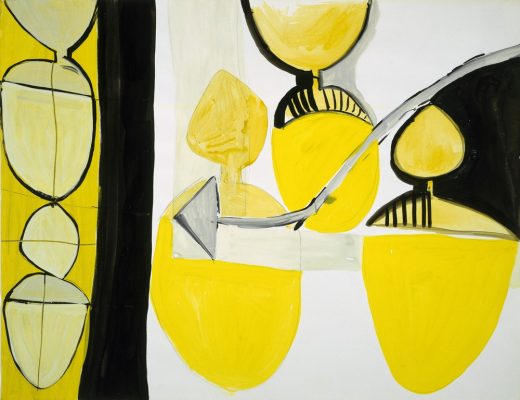
photograph courtesy of MFAHThree thematic installations will showcase strengths of the MFAH collection: holdings of works by Jasper Johns, Sam Gilliam, Claes Oldenburg, Howardena Pindell, Robert Rauschenberg); artists, including Louise Bourgeois, Chris Ofili, Kiki Smith, and Lisa Yuskavage, who convey personal meaning through reinterpretations of classical myths and religious stories or their own invented tales, in a presentation centered around Romare Bearden’s collage Odysseus Leaves Circe (1977); and artists’ responses to the world’s shifting environment, with works by Christiane Baumgartner, Huma Bhabha, Vija Celmins, Ólafur Elíasson, and Robyn O’Neil.
- The decorative arts, craft, and design department will show an international range of design and craft dating from 1890 to the present. A focus on British Reform, the Wiener Werkstätte, and the Bauhaus will include Josef Hoffmann’s rare Dining Chair from the Purkersdorf Sanatorium (1904) and one of the earliest known examples of Ludwig Mies van der Rohe’s Model MR 90 Chair (1930).
Gerrit Rietveld, RedBlue Chair:
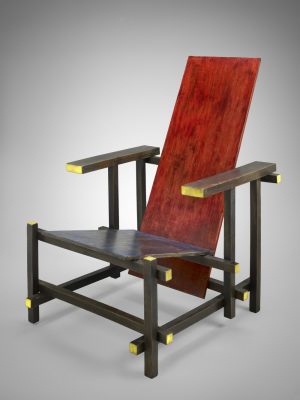
photograph courtesy of MFAHItalian design from 1960 to 1985 and contemporary design, including a selection of Ettore Sottsass’s ceramics (1950–68) and recent work by Ron Arad, Andrea Branzi, and Joris Laarman will also be highlighted. The galleries will include ample representation of the Museum’s distinguished craft collections, including works from the Garth Clark and Mark Del Vecchio Collection of contemporary ceramics; the Helen Williams Drutt Collection of contemporary jewelry; and the Leatrice S. and Melvin B. Eagle Collection of contemporary craft.
- The galleries for the department of photography will present more than 150 works from every period and major movement, 1840 to the present. In addition to this chronological presentation, thematic groupings cutting across borders, formats, and years highlight turning points in photographic history. Themes include French and American daguerreotypes, avant-garde photography in the period between the World Wars, Robert Frank’s epoch-making The Americans, and portraits that convey the variety and ubiquity of photography, from vernacular ID badges to a towering photomural by South African artist Zanele Muholi. A gallery of large-scale contemporary photographs features work by Sarah Charlesworth, Thomas Demand, Stan Douglas, Barbara Probst, Manjari Sharma, Laurie Simmons, Thomas Struth, and Guanyu Xu. Another presents video and time-based media by Fabiana Cruz, Diller and Scofidio, William Kentridge, Christian Marclay, Allison Schulnik, and others.
On the third floor, five exhibitions will address themes in contemporary art since the 1960s.
- Highlights of the Collectivity installation—which explores artists’ use of diverse materials and techniques to reflect on ideas of community—include the full set of Carrie Mae Weems’s Kitchen Table Series of photographs (1990); Mark Bradford’s monumental Circa 1992 (2015); vibrant lithographs by Wendy Red Star; Beatriz Gonzalez’s Mutis por el foro (1973), a metal bedframe depicting the death of Simón Bolivar; and Teresa Margolles’s Lote Bravo (2005), an installation of 400 adobe bricks, each made by hand out of the soil where murdered women had been buried in Ciudad Juárez.
- Color into Light highlights artists’ investigations of “color as a situation,” in the words of Carlos Cruz-Diez.
Josef Albers, Homage to the Square:
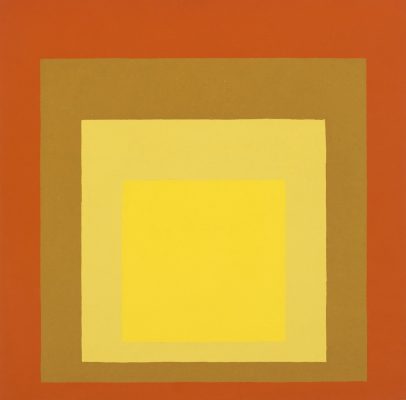
photograph courtesy of MFAHThis installation features work by artists celebrated for their study of color dynamics, including Cruz-Diez, Josef Albers, and Hans Hofmann, as well as Sam Gilliam, Hélio Oiticica, and Ettore Sottsass; neon pieces by Gyula Kosice and Keith Sonnier; investigations of transparency by Fred Eversley and Shiro Kuramata; and cameraless photographs by Christopher Bucklow and Susan Deges.
- LOL! features now-classic sculptures, photographs, and videos by Claes Oldenburg, Tony Oursler, Sandy Skoglund, and William Wegman, as well as surprising works including Anna and Bernhard Blume’s staged Oedipal Complications photographs (1977–78); Grupo Mondongo’s Plasticine Calavera 4 (2009), with its humorously re-contextualized sociopolitical, pop-culture, and art-historical references; improbable furniture prototypes by the Campana Brothers and KAWS (2000 and 2017); and Yoshitomo Nara’s untitled drawings of wide-eyed, devilishly cute, and mischievous girls (2005).
- Border, Mapping, Witness brings together works in all media that reflect on what it means to critically engage the notion of border as a flexible political, cultural, and psychological limit fraught with violence (James Drake, Ramiro Gomez, Luis Jiménez, Amalia Mesa-Bains, Camilo Ontiveros, Miguel Ángel Rojas, David Taylor); survey and rationalize a terrain (Carlos Garaicoa, Zarina Hashmid, Guillermo Kuitca, Julie Mehretu, Fazal Sheikh, Rosemarie Trockel, Norwood Viviano); and bear witness to the social injustices and cruel struggles of our time (Richard Avedon, Christian Boltanski, Erika Diettes, Melvin Edwards, Carmela Gors, Glenn Ligon, Oscar Muñoz, Betye Saar, Doris Salcedo, Kara Walker).
- Line into Space focuses on artists’ exploration of line, in which line is freed from representation, producing two- and three-dimensional objects that explore form, space, light, and transparency as autonomous elements. It features more than two dozen works by Gego, including drawings, sculptures, and a watercolor, presented with works including Jean Tinguely’s kinetic sculpture Méta-Malevich (1954) and Brice Marden’s painting Hydra, Summer 1990 (1990).
These first installations in the Kinder Building are accompanied by eight major site-specific commissioned works that will be inaugurated at the time of the opening. Commissioned artists are El Anatsui, Byung Hoon Choi, Carlos Cruz-Diez, Ólafur Elíasson, Trenton Doyle Hancock, Cristina Iglesias, Jason Salavon, and Ai Weiwei. These commissions join additional recent acquisitions to be featured in the Kinder Building, including works by Magdalena Abakanowicz, Glenn Ligon, Martin Puryear, Ursula von Rydingsvard, Doris Salcedo, and Kara Walker.
The Nancy and Rich Kinder Building stands in complementary contrast to the Museum’s existing gallery buildings—the Caroline Wiess Law Building (designed in the 1920s by William Ward Watkin, with later extensions by Ludwig Mies van der Rohe) and the Audrey Jones Beck Building (designed by Rafael Moneo, opened in 2000)—and in dialogue with the adjacent 1986 Lillie and Hugh Roy Cullen Sculpture Garden, designed by Isamu Noguchi. The trapezoidal concrete Kinder Building is clad in vertical glass tubes that emit a soft glow at night in a pattern across its facades. Five rectangular courtyard pools are inset along the perimeter, emphasizing the building’s openness to its surroundings.
The redevelopment of the Sarofim Campus and off-site art-storage facilities has been the largest cultural project in North America, with some 650,000 square feet of new construction. Steven Holl Architects designed the master plan for the redevelopment, along with the Kinder Building and a new home for the Glassell School of Art. Lake|Flato Architects designed the Museum’s new Sarah Campbell Blaffer Foundation Center for Conservation. Both the school and conservation center opened in 2018. Green spaces by Deborah Nevins & Associates, in collaboration with Mario Benito, unify the 14-acre campus and make it a walkable urban oasis in Houston’s increasingly dense Museum District.
Support for the Campus Project
The MFAH initiated its Campaign for the Museum of Fine Arts, Houston in January 2012 with a goal of $450 million, including the operating endowment. The campaign has exceeded expectations, raising more than $470 million to date. Based on the continued interest in Houston to support the Museum and the campaign, the MFAH has continued to fundraise.
Museum of Fine Arts Houston Nancy and Rich Kinder Building information / photos received 150920
Previously on e-architect:
Feb 2, 2012
Museum of Fine Arts Houston Expansion
New Facilities For Museum of Fine Arts, Houston
The Caroline Wiess Law Building, MFAH, by Mies van der Rohe:
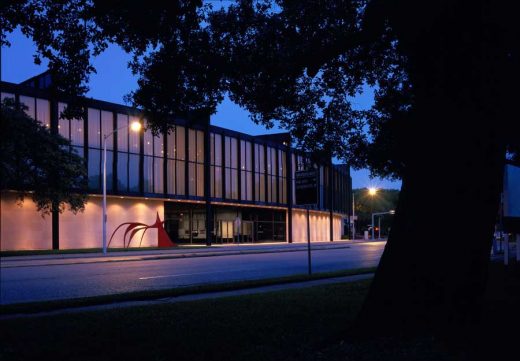
photograph © MFAH
Museum of Fine Arts Houston Expansion design by Steven Holl Architects, NY, USA
2011
Museum of Fine Arts Houston Expansion Architects
The Audrey Jones Beck Building, MFAH, by Rafael Moneo:
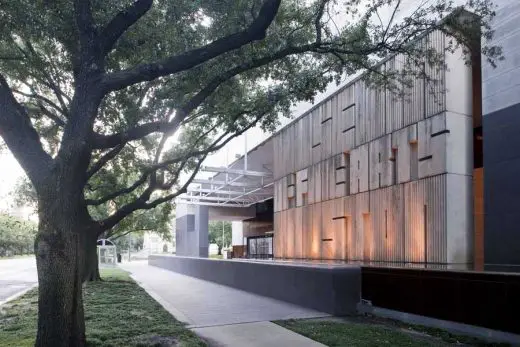
photograph © Robb Williamson
Museum of Fine Arts Houston original gallery building architect : Mies van der Rohe
Museum of Fine Arts Houston – existing gallery building architect : Rafael Moneo
Museum of Fine Arts Houston Expansion information from MFAH
Location: Museum of Fine Arts, Houston, Texas, USA
Houston Architecture
Houston Building Designs
Houston Architecture

images © Houston Airport System
Design: Marshall Strabala, Gensler
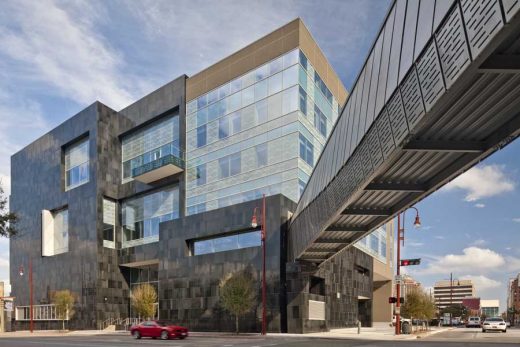
image : Nic Lehoux
Houston Ballet Building
Rice University Dormitories – North College redevelopment
Design: Hopkins Architects
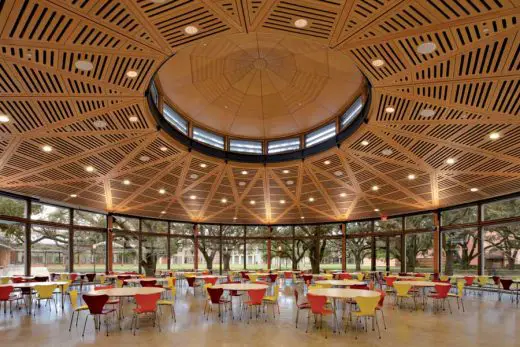
photo © Robert Benson
North College Rice University
General Services Administration Office Building
PageSoutherlandPage
GSA Field Office
Perot Museum of Nature & Science, Dallas
Morphosis
Perot Museum of Nature & Science
Museum of Contemporary Art Cleveland
American Architecture Designs
American Architectural Designs – recent selection from e-architect:
Buildings / photos for the Museum of Fine Arts Houston Expansion in Texas, USA, page welcome.

